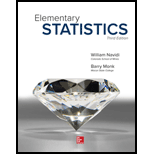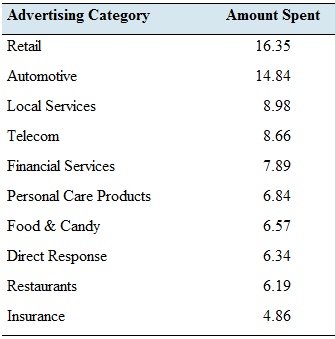
Concept explainers
Advertising costs: The amounts spent (in billions) on media advertising in the United States for a sample of categories are presented in the following table.

- Find the
mean amount spent on advertising. - Find the
median amount spent on advertising. - Find the sample variance of the advertising amounts.
- Find the sample standard deviation of the advertising amounts.
- Find the first
quartile of the advertising amounts. - Find the third quartile of the advertising amounts.
- Find the 40th percentile of the advertising amounts.
- Find the 65th percentile of the advertising amounts.
a)
To find mean.
Answer to Problem 12RE
Mean is 8.75.
Explanation of Solution
Given table:
| Amount spent |
| 16.35 |
| 14.84 |
| 8.98 |
| 8.66 |
| 7.89 |
| 6.84 |
| 6.57 |
| 6.34 |
| 6.19 |
| 4.86 |
Formula used:
Here n = 10.
Putting all values in formula,
Therefore, mean is 8.75.
b)
The median of given of amount spent.
Answer to Problem 12RE
Median is7.365.
Explanation of Solution
Given data sorted in ascending order:
| Amount spent |
| 4.86 |
| 6.19 |
| 6.34 |
| 6.57 |
| 6.84 |
| 7.89 |
| 8.66 |
| 8.98 |
| 14.84 |
| 16.35 |
Calculation:
Here n = 10 which is an even number.
Formula of median for even number is,
c)
To find sample variance.
Answer to Problem 12RE
Sample variance is 14.62.
Explanation of Solution
Creating table for sample standard deviation:
| 16.35 | 1.03 | 1.0609 |
| 14.84 | -0.48 | 0.2304 |
| 8.98 | -6.34 | 40.1956 |
| 8.66 | -6.66 | 44.3556 |
| 7.89 | -7.43 | 55.2049 |
| 6.84 | -8.48 | 71.9104 |
| 6.57 | -8.75 | 76.5625 |
| 6.34 | -8.98 | 80.6404 |
| 6.19 | -9.13 | 83.3569 |
| 4.86 | -10.46 | 109.4116 |
| Sum | 131.5 | |
Formula is,
Calculation:
From the table,
Put in a formula,
Sample variance = 14.62
d)
The sample standard deviation.
Answer to Problem 12RE
Sample standard deviation is 3.82.
Explanation of Solution
Sample variance is 14.62
Formula for sample standard deviation is,
e)
To find first quartile.
Answer to Problem 12RE
First quartile is 6.30.
Explanation of Solution
Given data sorted in ascending order:
| Amount spent |
| 4.86 |
| 6.19 |
| 6.34 |
| 6.57 |
| 6.84 |
| 7.89 |
| 8.66 |
| 8.98 |
| 14.84 |
| 16.35 |
Formula:
The first quartile is 6.30.
f)
The third quartile.
Answer to Problem 12RE
Third quartile is 10.445.
Explanation of Solution
Formula and calculation:
g)
To find 40th percentile is 6.678.
Answer to Problem 12RE
40th percentile.
Explanation of Solution
Given data sorted in ascending order:
| Amount spent |
| 4.86 |
| 6.19 |
| 6.34 |
| 6.57 |
| 6.84 |
| 7.89 |
| 8.66 |
| 8.98 |
| 14.84 |
| 16.35 |
Formula:
Since the position found is not an integer, the method of interpolation needs to be used. The 40% percentile is located between the values in positions 4 and 5. Those values, based on the data organized in ascending order, are 6.57 and 6.84.
The value of 4.4 - 4 = 0.4 corresponds to the proportion of the distance between 6.57 and 6.84 where the percentile we are looking for is located at.
Therefore,
h)
The 65th percentile.
Answer to Problem 12RE
65th percentile is 8.708.
Explanation of Solution
Since the position found is not integer, the method of interpolation needs to be used. The 65% percentile is located between the values in the positions 7 and 8. Those values, based on the data organized in ascending order, are 8.66 and 8.98.
The value of 7.15 - 7 = 0.15 corresponds to the proportion of the distance between 8.66 and 8.98 where the percentile we are looking for is located at.
Want to see more full solutions like this?
Chapter 3 Solutions
Elementary Statistics
- (b) Demonstrate that if X and Y are independent, then it follows that E(XY) E(X)E(Y);arrow_forward(d) Under what conditions do we say that a random variable X is integrable, specifically when (i) X is a non-negative random variable and (ii) when X is a general random variable?arrow_forward29. State the Borel-Cantelli Lemmas without proof. What is the primary distinction between Lemma 1 and Lemma 2?arrow_forward
- The masses measured on a population of 100 animals were grouped in the following table, after being recorded to the nearest gram Mass 89 90-109 110-129 130-149 150-169 170-189 > 190 Frequency 3 7 34 43 10 2 1 You are given that the sample mean of the data is 131.5 and the sample standard deviation is 20.0. Test the hypothesis that the distribution of masses follows a normal distribution at the 5% significance level.arrow_forwardstate without proof the uniqueness theorm of probability functionarrow_forward(a+b) R2L 2+2*0=? Ma state without proof the uniqueness theorm of probability function suppose thatPandQ are probability measures defined on the same probability space (Q, F)and that Fis generated by a π-system if P(A)=Q(A) tax for all A EthenP=Q i. e. P(A)=Q(A) for alla g // معدلة 2:23 صarrow_forward
 Big Ideas Math A Bridge To Success Algebra 1: Stu...AlgebraISBN:9781680331141Author:HOUGHTON MIFFLIN HARCOURTPublisher:Houghton Mifflin Harcourt
Big Ideas Math A Bridge To Success Algebra 1: Stu...AlgebraISBN:9781680331141Author:HOUGHTON MIFFLIN HARCOURTPublisher:Houghton Mifflin Harcourt Glencoe Algebra 1, Student Edition, 9780079039897...AlgebraISBN:9780079039897Author:CarterPublisher:McGraw Hill
Glencoe Algebra 1, Student Edition, 9780079039897...AlgebraISBN:9780079039897Author:CarterPublisher:McGraw Hill Holt Mcdougal Larson Pre-algebra: Student Edition...AlgebraISBN:9780547587776Author:HOLT MCDOUGALPublisher:HOLT MCDOUGAL
Holt Mcdougal Larson Pre-algebra: Student Edition...AlgebraISBN:9780547587776Author:HOLT MCDOUGALPublisher:HOLT MCDOUGAL



